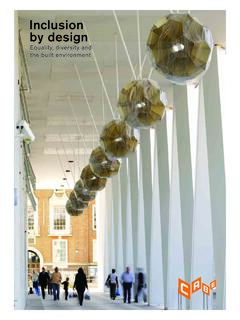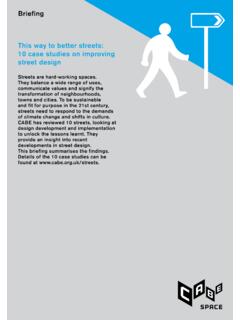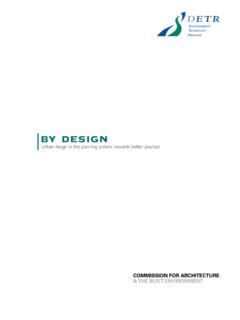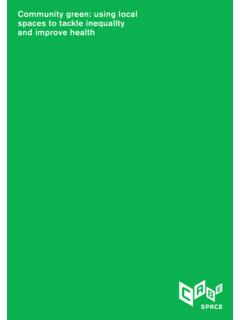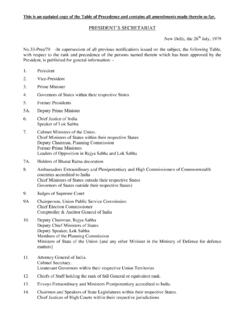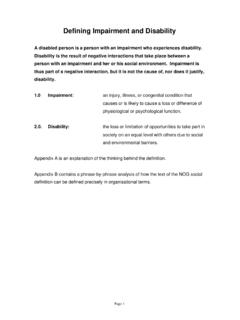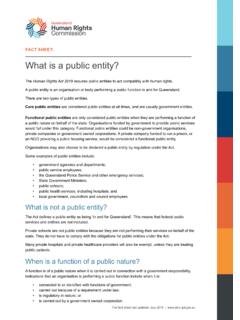Transcription of Design and access statements - Design Council
1 Design and access statements How to write, read and use them Published in 2006 by the Commission for Architecture and the Built Environment. Reprinted in 2007. Graphic Design by Draught Associates. Printed by Sandypress on Starfine environmentally friendly paper. Cover photo: Pepys Estate, London David Millington Photography Ltd. All rights reserved. No part of this publication may be reproduced, stored in a retrieval system, copied or transmitted without the prior written consent of the publisher except that the material may be photocopied for non-commercial purposes without permission from the publisher. This document is available in alternative formats on request from the publisher. CABE is the government's advisor on architecture, urban Design and public space. As a public body, we encourage policymakers to create places that work for people. We help local planners apply national Design policy and offer expert advice to developers and architects.
2 We show public sector clients how to commission buildings that meet the needs of their users. And we seek to inspire the public to demand more from their buildings and spaces. Advising, influencing and inspiring, we work to create well-designed, welcoming places. CABE. 1 Kemble Street London WC2B 4AN. T 020 7070 6700. F 020 7070 6777. E Contents Introduction 5. Part 1: Explaining the tools 6. Part 2: Writing statements 11. Part 3: Reading statements 21. Glossary 30. Assessment crib sheet 32.. Butts Green, Warrington David Millington Photography Ltd. Introduction In May 2006, the government introduced changes to the planning applications process. The circular Guidance on changes to the development control system, effective from 10 August 2006, sets out the formal requirements. This guide explains how the changes can help make sure we create high-quality places that are easy for everyone to use. It also shows how the process of making a planning application encourages everyone to think about how inclusive, practical and attractive a place will be once it is built.
3 This guide is divided in three sections: Part 1: Explaining the tools Explains what Design and access statements are and how they work with both detailed and outline planning applications. Part 2: Writing statements Shows people who are writing statements what to include, and the best way to explain their scheme. This section includes examples of good statements , explaining why they worked well. Part 3: Reading statements Explains how local authority planners and councillors and anyone else considering a planning application can use statements to check if the proposal is good enough to approve. The section runs through each of the things a statement has to include, suggesting questions that would help determine how good the buildings and spaces would be once they were built. This guide is intended as best practice guidance to accompany the circular Guidance on changes to the development control system. Its contents are therefore CABE's interpretation of government policy and should be considered best practice rather the statutory minimum.
4 To make it easier for you to find your way around this guide, a colour code has been used to link the related sections in parts 1, 2, and 3. The same colour code is used in the assessment crib sheet which can be found on the fold out flap inside the rear cover. You might find it useful to fold out the assessment crib sheet now to help navigate the guide. Jennie Daly, who is director of planning at Harrow Estates, commented on a Design and access statement presented by Taylor Young for a proposal at Ellesmere Port: The Design and access statement has, in this case, served as visible proof of the Design evolution of the site having regard to best practice and guidance. In addition, it provides a tangible link, for all those interested in the development of the site, between the technical assessment of constraints and the best scenario Design response to them.'.. Part 1. Explaining the tools Most development needs planning permission.
5 This helps local authorities manage change in their areas for the benefit of the public. But they need to understand the likely effect of any proposals to make well-informed and balanced decisions. Design and access statements ( statements for short) can help provide a lot of the information needed. They should help to make the planning applications system work more smoothly. What are Design and access statements ? statements are documents that explain the Design thinking behind a planning application. For example, they should show that the person applying for permission (the applicant) has thought carefully about how everyone, including disabled people, older people and very young children, will be able to use the places they want to build. statements should include a written description and justification of the planning application. Sometimes photos, maps and drawings may be needed to further illustrate the points made.
6 They will be available alongside the application for anyone to see, so should avoid jargon or overly technical language. It is important that they are written specifically for the application they accompany. They need not be very long, but the amount of detail they contain should reflect how complex the application is. So, a statement for a major development is likely to be much longer than one for a single building. In summary, statements : accompany a planning application, but are not part of it are needed with most types of application, but not householder applications (except in designated areas) or material change of use (unless it also involves operational development). are also required for applications for listed building consent need to explain and justify what is being applied for, and can be linked to planning decisions by conditions if developers are to be required to follow them The circular, Guidance on changes to the development control system, says that statements should explain the Design principles and concepts that have informed the development and how access issues have been dealt with.
7 So, although there will be a Design and an access component, you should not think of a Design and access statement as two separate documents. Much of the preliminary work that needs to be done for the Design component will help inform the access component and vice versa. Additionally, the approach to inclusive access should not be limited to the access part of the statement it should infuse the whole document.. Design The process How the physical characteristics of the scheme have been informed by a rigorous process which should include the following steps: assessment involvement evaluation Design . Use What buildings and spaces will be used for. Amount How much would be built on the site. Layout How the buildings and public and private spaces will be arranged on the site, and the relationship between them and the buildings and spaces around the site. Scale How big the buildings and spaces would be (their height, width and length).
8 Landscaping How open spaces will be treated to enhance and protect the character of a place. Appearance What the building and spaces will look like, for example, building materials and architectural details. access The statement needs to include two potential aspects of access . That is not to say they are separate, and the statement should show that all access issues have been considered together. Vehicular and transport links Why the access points and routes have been chosen, and how the site responds to road layout and public transport provision. Inclusive access How everyone can get to and move through the place on equal terms regardless of age, disability, ethnicity or social grouping.. statements should demonstrate how development can create accessible and safe environments, including addressing crime and disorder and fear of crime. These may be particularly relevant to address under layout and landscaping themes.
9 Early consultation with police will help identify key issues in your local area, and measures to help address these. Safer places - the planning system and crime prevention (ODPM/Home Office, 2004) contains more information. statements may include other information as well, either because applicants think it is relevant or because local policies say they should, or because applicants want to include other information that they feel is relevant. For example, statements can explain the energy performance of buildings or whether they meet Design standards such as Lifetime Homes or Building for Life Standards, or they may explain how the public has influenced the plan. statements and outline planning applications At the same time as a formal requirement for statements was introduced, the rules about outline applications were also changed so that they must include a minimum level of detail on: what the buildings will be used for how many buildings there will be roughly how they will be laid out minimum and maximum building sizes, and where entrances to the site will be.
10 The changes to the list of reserved matters, and the minimum information that now needs to be submitted at outline stage can be found in the circular, Guidance on changes to the development control system and the related regulations (statutory instrument 2006 ). For convenience, they are listed to the rear of this guide on page 31. The statement accompanying the outline application should explain and justify the decisions taken so far but, very importantly, it must also explain the principles that will be followed when all the details are designed after permission is granted. The statement should set out the aims for the whole Design , even if many of the details still have to be drawn up. The developer should keep within the parameters set out in the statement, and the outline permission may need to include conditions to make sure the ideas and aims in the statement are followed through as the Design progresses.


